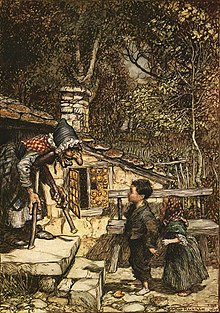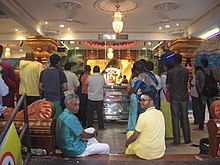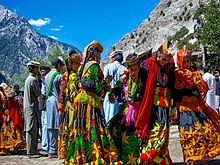Folklore
A more modern definition of folk is a social group that includes two or more people with common traits who express their shared identity through distinctive traditions.[11] In direct contrast to high culture, where any single work of a named artist is protected by copyright law, folklore is a function of shared identity within a common social group.That meaning can, however, shift and morph; for example, the Halloween celebration of the 21st century is not the All Hallows' Eve of the Middle Ages and even gives rise to its own set of urban legends independent of the historical celebration; the cleansing rituals of Orthodox Judaism were originally good public health in a land with little water, but now these customs signify for some people identification as an Orthodox Jew.By comparison, a common action such as tooth brushing, which is also transmitted within a group, remains a practical hygiene and health issue and does not rise to the level of a group-defining tradition.A particular figure in this development was Johann Gottfried von Herder, whose writings in the 1770s presented oral traditions as organic processes grounded in the locale.Its focus was the oral folklore of the rural peasant populations, which were considered as residues and survivals of the past that continued to exist within the lower strata of society.When the American Folklife Preservation Act (Public Law 94-201) was passed by the U.S. Congress in January 1976,[20] to coincide with the Bicentennial Celebration, folkloristics in the United States came of age.Added to the extensive array of other legislation designed to protect the natural and cultural heritage of the United States, this law also marks a shift in national awareness.There is also a fourth major subgenre defined for children's folklore and games (childlore), as the collection and interpretation of this fertile topic is particular to school yards and neighborhood streets.[26] Each of these genres and their subtypes is intended to organize and categorize the folklore artifacts; they provide common vocabulary and consistent labeling for folklorists to communicate with each other.The formal definition of verbal lore is words, both written and oral, that are "spoken, sung, voiced forms of traditional utterance that show repetitive patterns.As the number of classified oral artifacts grew, similarities were noted in items that had been collected from very different geographic regions, ethnic groups, and epochs, giving rise to the Historic–Geographic Method, a methodology that dominated folkloristics in the first half of the 20th century.Over the past two centuries, this belief has proven to be wrong; folklorists continue to collect verbal lore in both written and spoken form from all social groups.Just as verbal lore continues to be actively created and transmitted in today's culture, so these handicrafts can still be found all around us, with possibly a shift in purpose and meaning.There are many reasons for continuing to handmake objects for use, for example these skills may be needed to repair manufactured items, or a unique design might be required which is not (or cannot be) found in the stores.[34] For the folklorist, these hand-crafted objects embody multifaceted relationships in the lives of the craftspeople and the users, a concept that has been lost with mass-produced items that have no connection to an individual craftsperson.Folk art is found in hex signs on Pennsylvania Dutch barns, tin man sculptures made by metalworkers, front yard Christmas displays, decorated school lockers, carved gun stocks, and tattoos.These festivals and parades, with a target audience of people who do not belong to the social group, intersect with the interests and mission of public folklorists, who are engaged in the documentation, preservation, and presentation of traditional forms of folklife.For childhood is a social group where children teach, learn and share their own traditions, flourishing in a street culture outside the purview of adults.[44] Of particular interest to folklorists here is the mode of transmission of these artifacts; this lore circulates exclusively within an informal pre-literate children's network or folk group.[46] Early folklorists, among them Alice Gomme in Britain and William Wells Newell in the United States, felt a need to capture the unstructured and unsupervised street life and activities of children before it was lost.A case has been made for considering folk history as a distinct sub-category of folklore, an idea that has received attention from such folklorists as Richard Dorson.It is self-evident that this fits well with all types of verbal lore, where reality has no place among the symbols, fantasies, and nonsense of traditional tales, proverbs, and jokes.Even so, when considering context, the structure and characteristics of performance can be recognized, including an audience, a framing event, and the use of decorative figures and symbols, all of which go beyond the utility of the object.The tradition-bearer[54] is the individual who actively passes along the knowledge of an artifact; this can be either a mother singing a lullaby to her baby, or an Irish dance troupe performing at a local festival.This expanded model of redundancy in a non-linear narrative process makes it difficult to innovate during any single performance; corrective feedback from the audience will be immediate.[63] "At the heart of both autopoetic self-maintenance and the 'virality' of meme transmission... it is enough to assume that some sort of recursive action maintains a degree of integrity [of the artifact] in certain features ... sufficient to allow us to recognize it as an instance of its type.[69] The fairy tale Snow White is now offered in multiple media forms for both children and adults, including a television show and video game.Yeh et al. (2023) suggest that user-generated content (UGC) should be considered as folklore, especially in mental health communities, because it conveys informal, unofficial knowledge through first-hand stories of treatment experiences.They provide insight into mental health consumers' experiences with antidepressants, highlighting where they obtain information, gaps in their knowledge, and obstacles to seeking or continuing treatment.















Folklore (disambiguation)Hansel and GretelArthur Rackhampeopleculturesubcultureoral traditionslegendsproverbsmaterial culturefolk religionChristmasfolk dancesinitiation ritesfolklore artifacttraditional cultural expressionfine artsfolklore studiesBatu CavesSelangorPlovdivBelgradeWilliam ThomsAmerican folkloresingle family.folk artifactshigh culturecopyright lawHalloweenurban legendsOrthodox Judaismtooth brushingsocial sciencesJohann Gottfried von HerderNapoleonic Francenation buildingtraditionmodernityKinder- und HausmärchenBrothers GrimmEuropean folkloristsFranz BoasRuth BenedictNative Americancultural anthropologyethnologyhumanitiesfolklore artifactsBicentennial Celebrationcultural heritageSmithsonian Folklife Festivalfolklife festsWilliam Bascomsocial pressuresocial controlMansourasocial groupsfamily folkloreJournal of American FolkloreRichard Dorsonchildren's folkloresignifiersJahangirAnarkaliMughal Empirenarrative typesOld MacDonald Had a FarmAntti AarneAarne–Thompson classification systemStith ThompsonBalladsBlessingsBluegrassChantsCharmsCinderellaCountry musicCowboy poetryCreation storiesCursesEpic poetryFairy taleFolk beliefFolk etymologiesFolk metaphorsFolk poetryFolk musicFolksongsFolk speechoral traditionGhostloreGreetingsHog-callingInsultsKeeningLatrinaliaLimericksLullabiesLeave-taking formulasFakelorePlace namesPrayers at bedtimeRiddleRoastsSea shantiesStreet vendorsSuperstitionTall taleTauntsToastsTongue-twistersWord gamesYodelingdreidelsPodhaleIndustrial Revolutionhandicraftsapplied artsfolk artliving museumheritage industryAutograph booksEmbroideryFolk costumeFolk medicinesFood recipes and presentation
